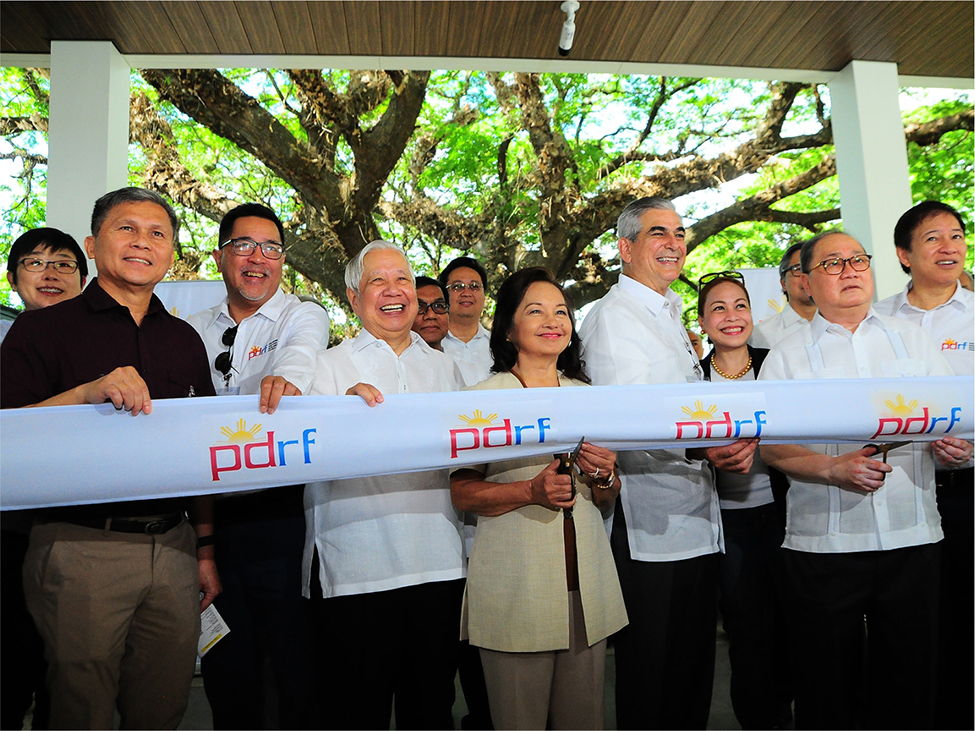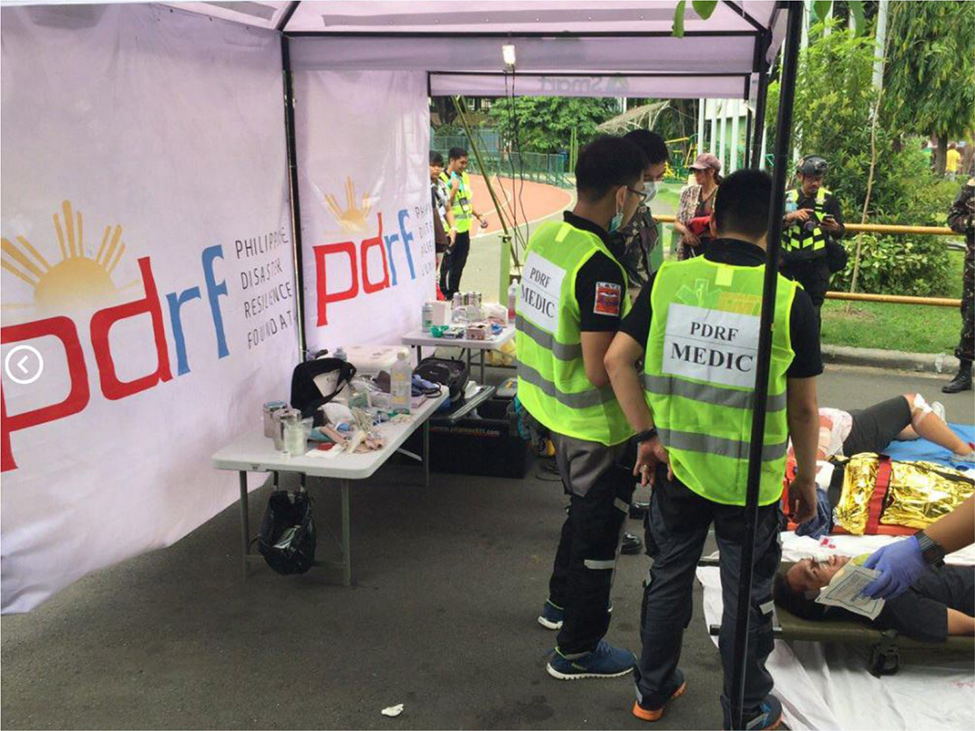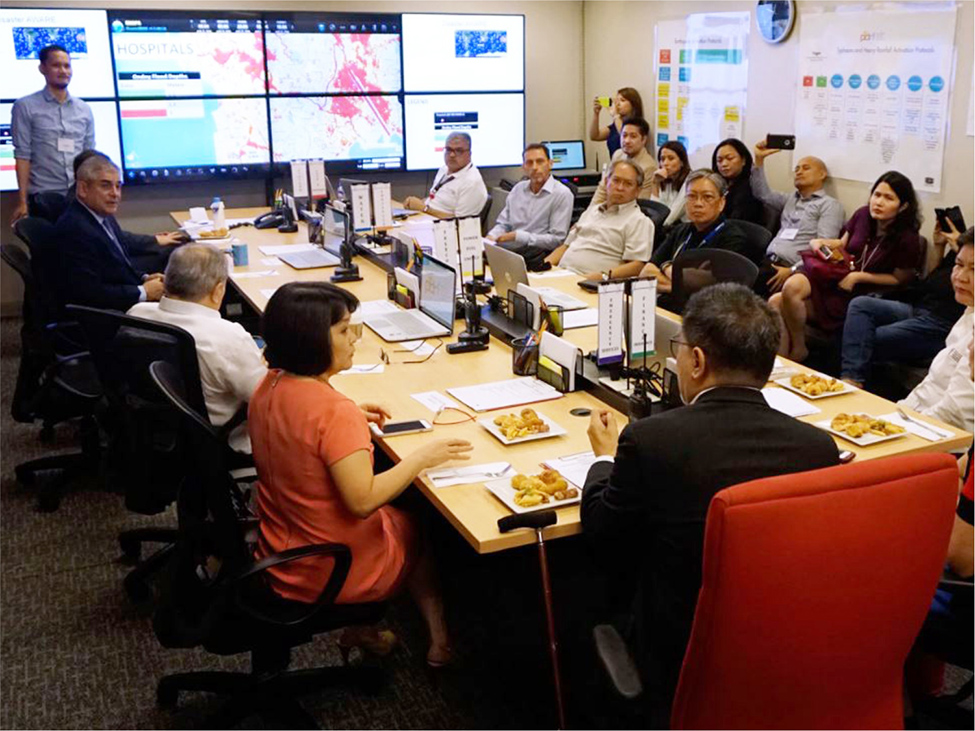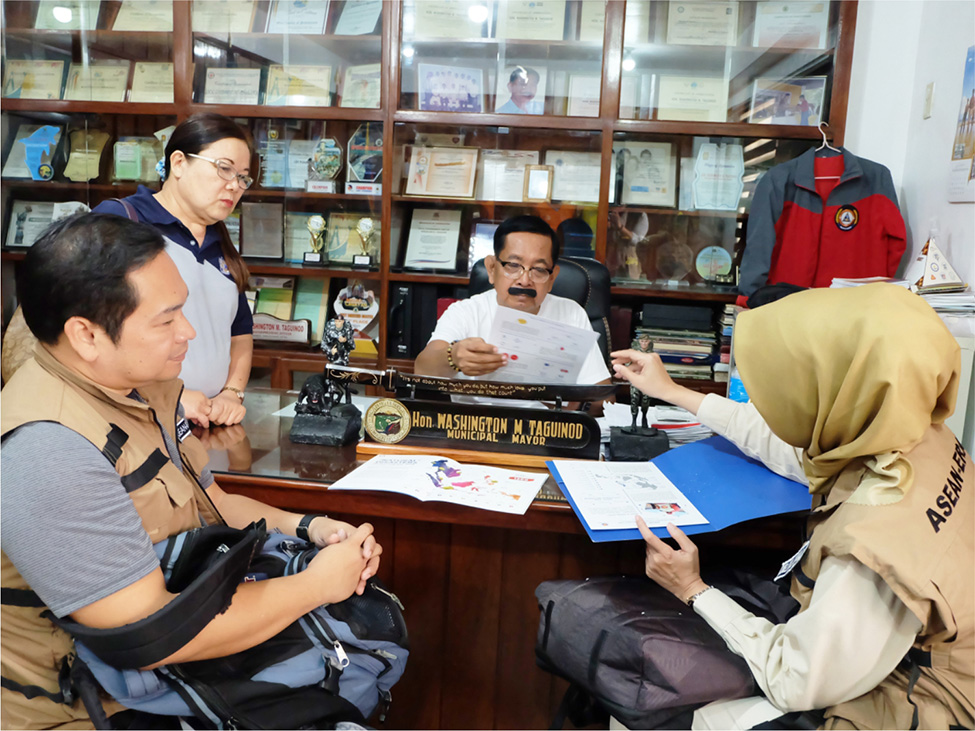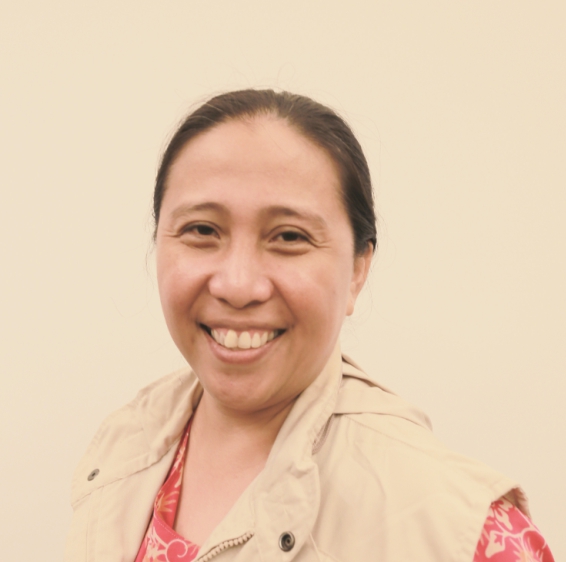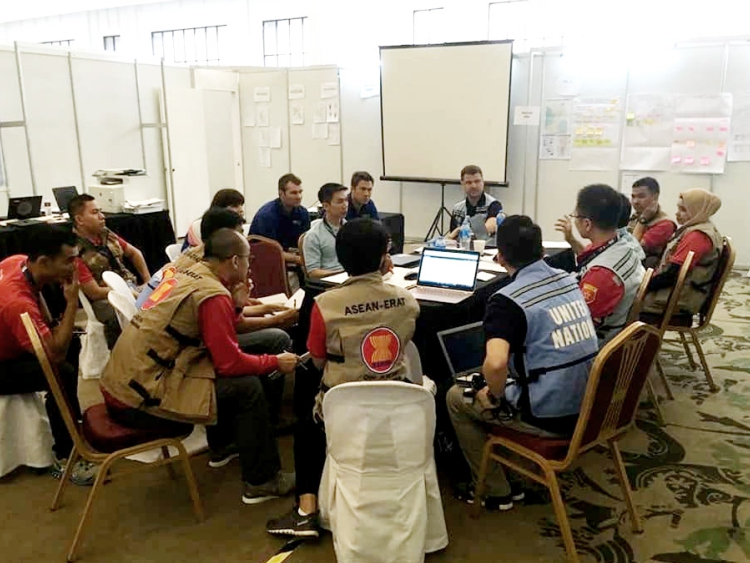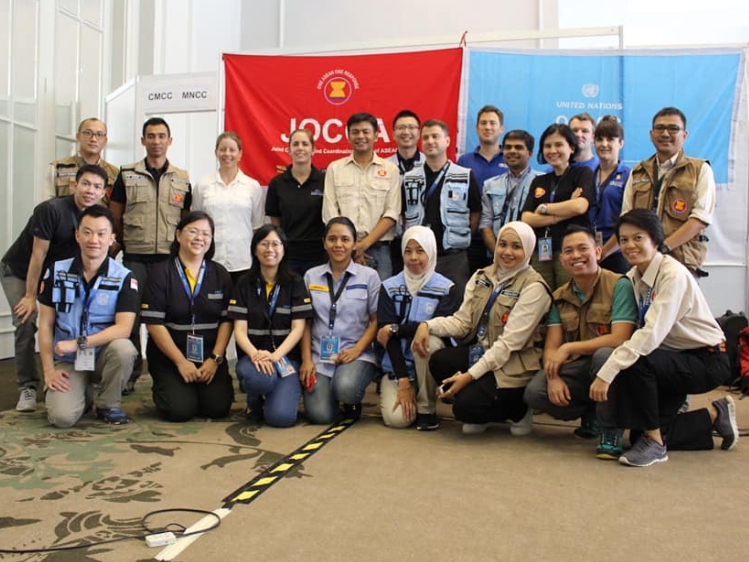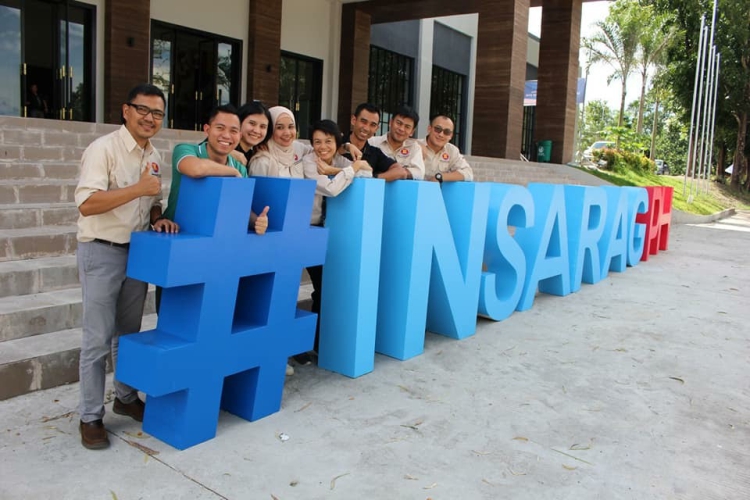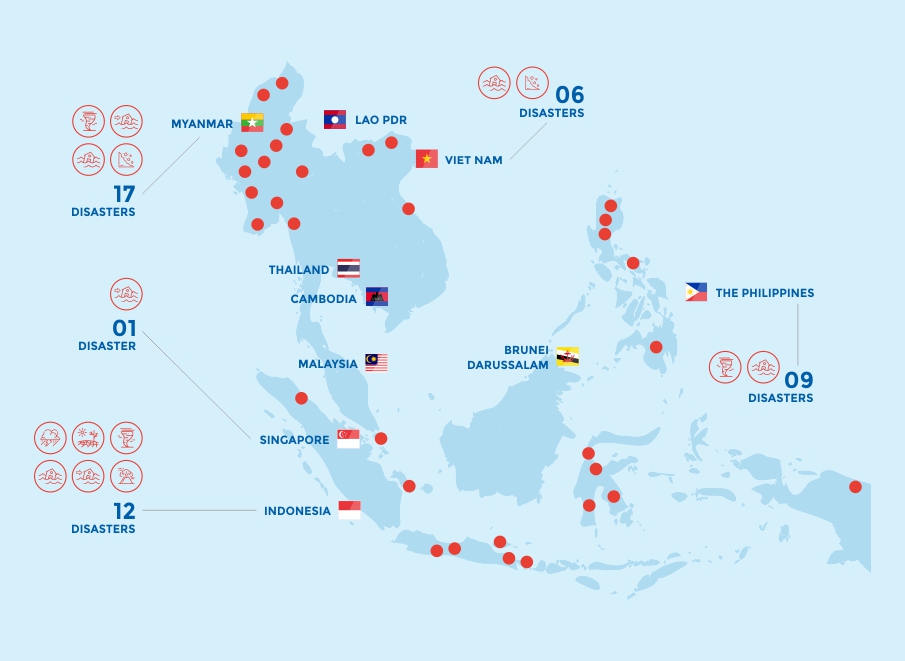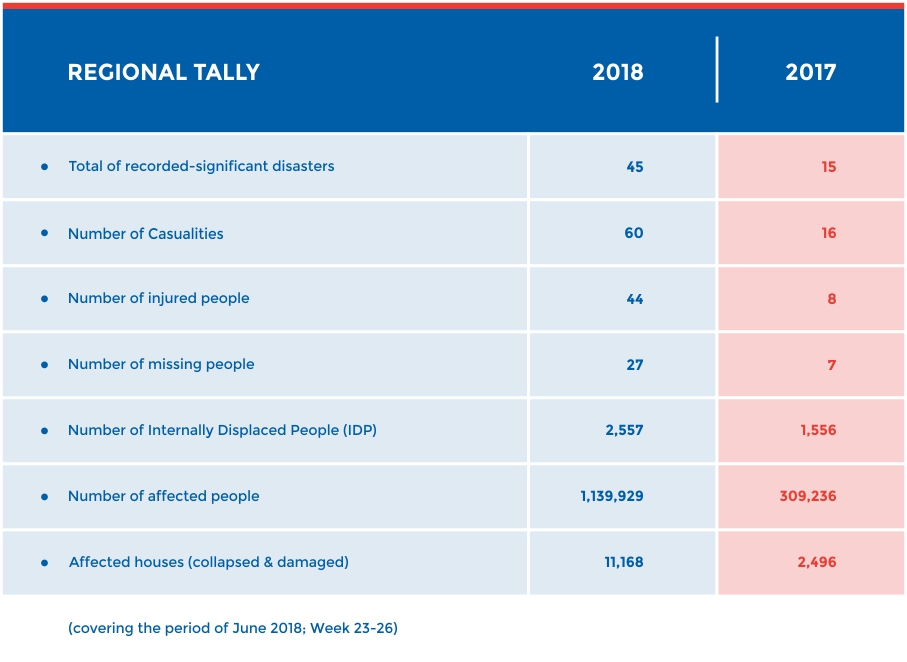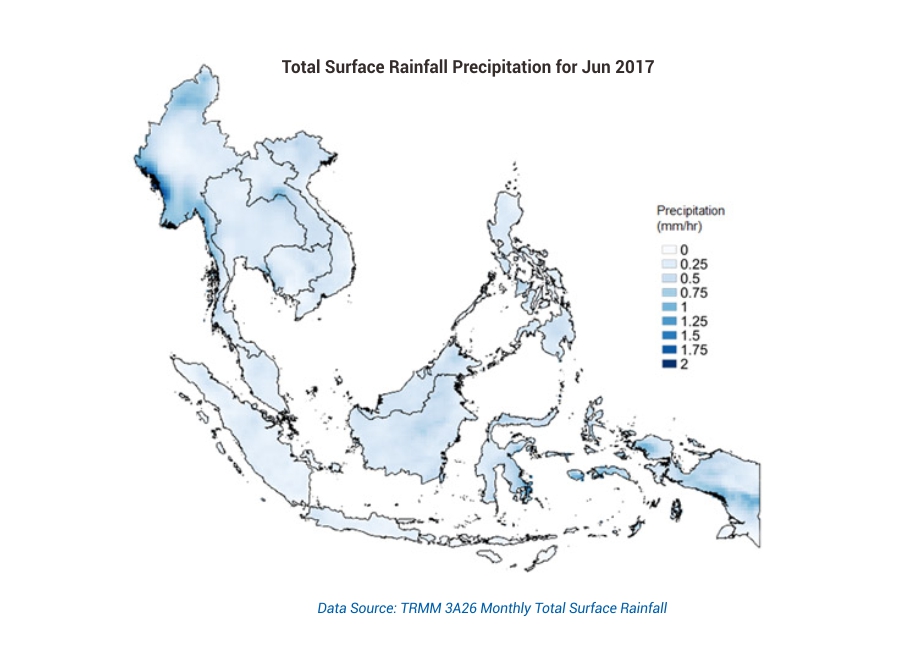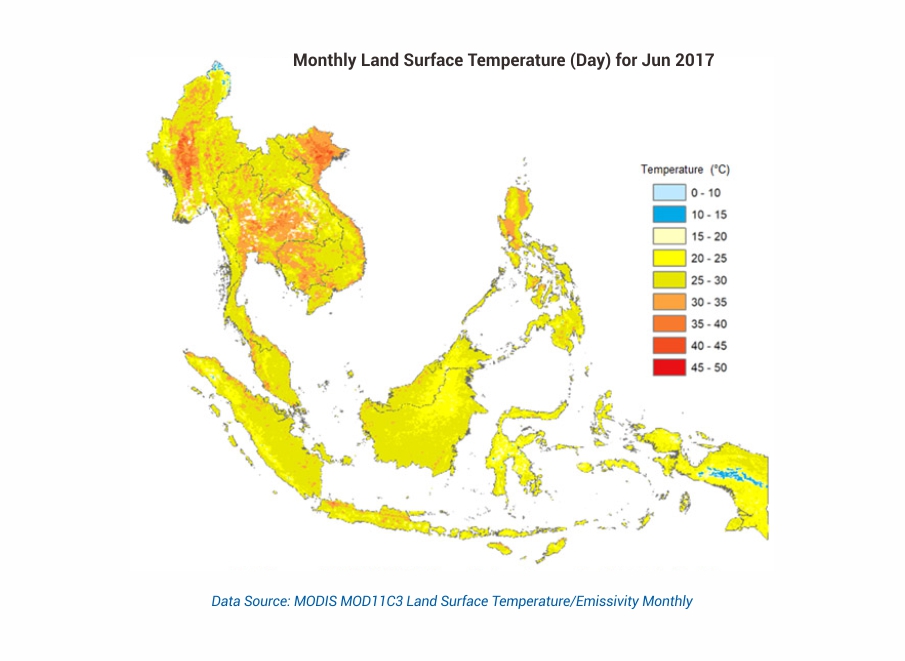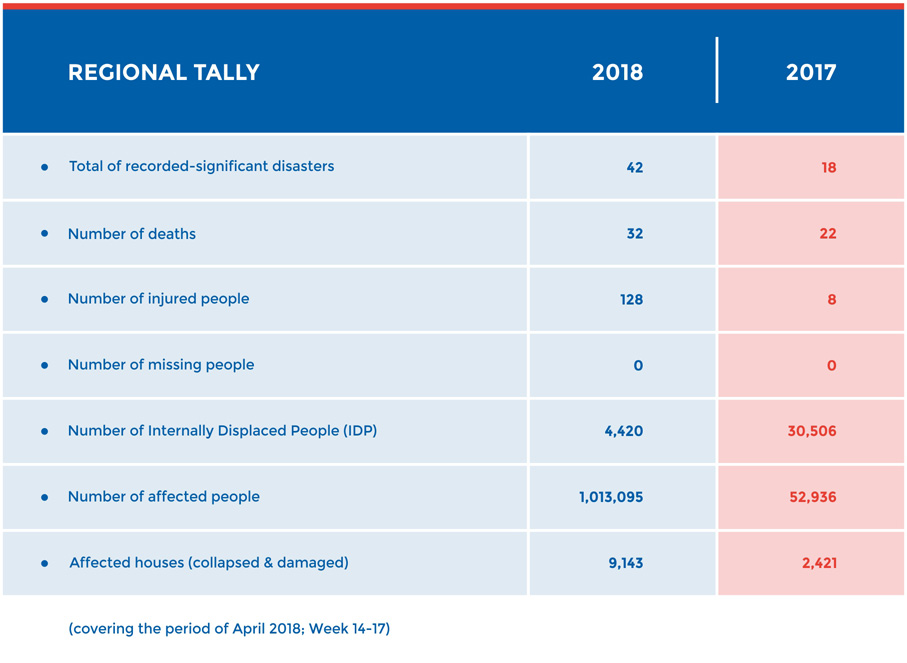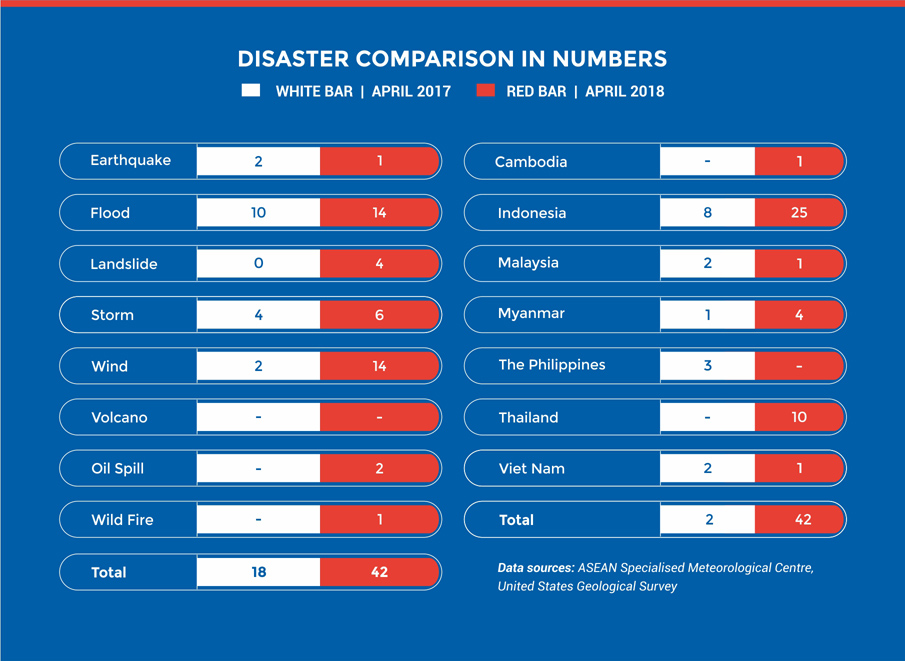Vol 43-PDRF The Philippine Disaster Resilience Foundation

PDRF
THE PHILIPPINE DISASTER RESILIENCE FOUNDATION
The Philippine Disaster Resilience Foundation (PDRF) is a unique organisation, who forms the major coordinating body for the Philippines’ private sector engagement and support on disaster management. The ASEAN region has become increasingly aware of the importance of private sector engagement in disaster management field, as well as the value that such engagement can foster, with organisations such as the PDRF providing strong examples of the strong, responsive and skilled resources that can support the overall disaster management efforts of this disaster-prone region.
Over recent years, the AHA Centre has turned its focus more heavily to the engagement of the private sector throughout its disaster management work, based on the reasons above, alongside the private sector’s own realisation that disaster is something that impacts them heavily – and that they need to do more to support with ongoing efforts. The PDRF mission and work form a solid match with the AHA Centre, therefore their partnership is mutually beneficial on many levels. The partnership was first formalised in April 2017, with Ms. Adelina Kamal, the (then acting) Executive Director of the AHA Centre, and PDRF President Rene Meily putting pen to paper to formalise this valuable agreement.
The PDRF itself is composed from a team of highly committed professionals who work alongside field experts and reputable humanitarian institutions to organise, coordinate, and solidify the commitment of the private sector within overall disaster management efforts. The PDRF has been a leader in effective reconstruction measures that address the needs of disaster-stricken communities, with their programmes developed for post-disaster recovery in key sectors such as shelter, livelihood, education, environment and water, infrastructure, sanitation, and health. Alongside this, they operate their own state-of-the-art operations and communications centre, engage in community resilience programmes, and support the business sector across a range of elements related to disaster preparedness as well as business resilience in the event of disaster.
Within this context, the AHA Centre PDRF partnership focuses towards supporting and advocating increases in public knowledge and awareness regarding disaster management. Through PDRF’s support of One ASEAN One Response, there will be a range of exchanges and knowledge sharing activites, that will be mutually reliant on each other’s assets and expertise, in order to increase and boost the capacity and capability in responding to disaster. In addition, the partnership will encourage private sector and start-up businesses to be more engaged, and share more ideas for disaster preparedness, disaster risk reduction and management, and resilient recovery.
Written by : Valerie Bayhon, William Shea | Photo : PDRF
- Published in Partnership
Vol 43-ONE ASEAN ONE RESPONSE for Typhoon Mangkhut

ONE ASEAN ONE RESPONSE
FOR TYPHOON MANGKHUT
By mid-September it was all-hands-on-deck in the AHA Centre, with the monitoring team tracking the formation of largest storm cell of the year so far, as it made its way across the Pacific Ocean with a population of millions across the Philippines directly in its path. Communities along the nation’s northern coastline and outer islands were being evacuated, as preparation was well underway for the onset of Super Typhoon Mangkhut (Ompong). On the 15th of September, Typhoon Mangkhut made landfall in Cagayan Province, continuing its path westward with extreme winds and lashing rain, and leaving in its trail over 2.5 million people affected across the Philippines.
Afterwards, a total of 8 provinces and seven cities/municipalities have been announced under state of emergencies, with widespread damage to homes, infrastructure and livelihoods. Typhoon Mangkhut – that had an actual diameter larger than 2013’s Typhoon Haiyan – claimed over 50 lives, with hundreds more injured, and over 180,000 homes either fully or partially damaged. Total damage has been estimated at over USD 6 million, with communities particularly affected by secondary hazards that accompanied the typhoon, such as flooding and landslides. However, was it not for the coordinated effort in the days prior to the storm by the various national and sub-national agencies, alongside communities themselves, loss of life and damage could have been far worse.
“We pre-positioned the Cagayan Valley Response Team in advance, with early evacuation taking place two days prior to the typhoon’s landfall. We also estimated the numbers of people likely to be affected, and provided hygiene kits, non-food items, and generators. These preparedness measures managed to minimise casualties in our region”, explained Mr. Dante Balao, the Regional Director of Office of Civil Defense (OCD) Regional Office II, in Tuguegarao, Cagayan.
Alongside tracking the progress of Typhoon Mangkhut in the weeks and days leading-up to the disaster, the AHA Centre was also engaged with the Philippines Government, through the Philippines’ National Disaster Risk Reduction and Management Council (NDRRMC), in both the preparation and response to the storm. At a later stage, the ASEAN Emergency Response and Assessment Team (ERAT) was mobilised to provide information management and assessment report as the emergency phase coming to an end. On the 15th of September, just hours after the typhoon made landfall, the AHA Centre In-Country Liaison Team arrived in the Philippines, to establish direct communication with the NDRRMC in Manila and in affected areas, and to facilitate ASEAN’s assistance to those in need.
In response to the disaster, the AHA Centre mobilised relief items valued at over USD 275,000 to communities across the affected regions, including 30 tonnes of rice, four generator sets, and 2,000 rolls of tarpaulins. During the handover ceremony on September 24th, Undersecretary Ricardo B. Jalad, the Executive Director of NDRRMC and the Administrator of the Philippines’ Office of Civil Defense showed his appreciation for ASEAN’s support when he stated “I would like to thank and express my deep gratitude to the AHA Centre for facilitating this assistance”.
While Typhoon Mangkhut was a disastrous event for the Philippines and the ASEAN region, it presented an opportunity for the AHA Centre and ASEAN-ERAT to engage on a new element as part of the region’s ongoing efforts to improve disaster management practices. Three ASEAN-ERAT information management specialists were deployed to support the NDRRMC office with data analysis, data visualisation and report writing. One of the ASEAN-ERAT Level 2 members deployed to the Philippines, Adiratna Wira from Malaysia, recognised the importance of information management support for response agencies during disasters. “Aside from the actual products developed, there was great benefit for both the NDRRMC and ASEAN-ERAT members”, said Adiratna. “There was increased understanding in the roles and ways of working for each party, which could speed-up a range of processes and information distribution in the future.”
On the last day of the ASEAN-ERAT’s deployment, Mr. Edgar Posadas, the Director of Operations Service and Spokesperson of the NDRRMC emphasised, “we know that our region is always at risk of disasters, but with neighbours like you and friends like you, we know that things will be moving forward. We are thankful to our ASEAN neighbours and the AHA Centre for your help. The ASEAN region is advancing, we don’t have to go beyond our borders (to respond to disasters), so those beyond the ASEAN corridors can attend to their own disasters. I think it’s a way to go now, everybody is trying to be self-sufficient. We have to be ready should simultaneous disasters are taking place. So, the more capacity that we have and the more prepared we are, the better it will be for the people”.
Written by: Shintya Kurniawan | Photo : AHA Centre
- Published in Highlight
Vol 36-Gaynor Tanyang

Gaynor Tanyang
Managing Director, Lumina Ventures
ASEAN-ERAT Member from the Philippines
Gaynor’s path into the disaster management field, and direct engagement as an ASEAN ERAT member was formed through more than ten years of work in the development sector. Her first experience directly with disaster management in the ASEAN context came when she joined Oxfam on a programme being implemented within the AADMER partnership. She tells the AHA Centre, “I was just volunteering with a local organisation, when a contact recommended I apply for the role”.
Having gained some disaster-related experience in her time undertaking gender audits of disaster responses, Gaynor first heard of the AHA Centre through Oxfam’s support to the ASEAN Secretariat developing this new disaster management institution in 2011. She then acted as an observer of the 2013 ASEAN-ERAT training course, managing the simulation exercises, before strengthening her involvement by undertaking the role of facilitator during a 2014 ASEAN-ERAT refresher training. It is this training element that forms a large part of Gaynor’s passion for the work. “Most of my work with NGOs involved training, so that is what I really enjoy most” she states.
As an ASEAN-ERAT member, Gaynor has experienced one deployment. It was this deployment, however, that influenced significant change in the landscape and format of the ASEAN-ERAT course. The deployment was to her home nation of the Philippines, and the assignment was as an initial responder to the devastating Typhoon Haiyan that struck Tacloban in late 2013. Gaynor’s arrival into the affected area was an experience that would stay with her. “Usually, even after a disaster, there are still markets, and people are still going about their lives – but Haiyan was different.
Everything was destroyed. There were no markets, no shops open – no-one cared about your money” she recalls. “When we arrived in Tacloban, our only water was a half-bottle left over from our lunch”.
“AT THAT TIME, WE WERE NOT FULLY PREPARED, AND THIS PREPAREDNESS IS A KEY LESSON WE LEARNED FROM HAIYAN.” GAYNOR ADMITS. “TRAINING CAN HELP YOU PREPARE TO SOME DEGREE, BUT HAIYAN WAS JUST SO DIFFERENT. THE DEVASTATION WAS SO MASSIVE. ALL ASPECTS OF LOGISTICS WERE EXTREMELY CHALLENGING.”
Local knowledge and connections formed key elements of Gaynor’s and the other ASEAN-ERAT members’ ability to gain access to the disaster zone. Without their local Filipino contacts, gaining vehicles and transportation would have been almost impossible. This stands as one of Gaynor’s tips to first responders – “take advantage of local connections and personal contacts”.
The lessons learned from the Haiyan response have guided the AHA Centre during its more recent development, and Gaynor played a central role in the development of these lessons and the recommendations that followed. “After my experience in Haiyan, I realised that the ERAT course needed some changes” she recalls. Her input was accomodated when the AHA Centre expands the roles of ASEAN-ERAT, from assessment towards responses, including pre-deployment preparation. Regarding this preparedness, Gaynor’s primary tip to responders is to “expect the worse – take a bare minimum of items to survive in trying conditions and always carry a strong sense of purpose.”
Written by : William Shea | Photo : AHA Centre
- Published in The Other Side
Vol 40-International Search and Rescue Advisory Group (INSARAG) Training Exercise

INTERNATIONAL SEARCH AND RESCUE ADVISORY
GROUP (INSARAG) TRAINING EXERCISE
CLARK FREE PORT, PAMPANGA,THE PHILIPPINES, 26-29 JUNE 2018
Testing, refining and streamlining the AHA Centre’s disaster coordination mechanisms is integral to ensuring ease of implementation in disaster responses. This year’s International Search and Rescue Advisory Group’s (INSARAG) exercise, held in Clark Free Port from the 26th to the 29th of July allowed the AHA Centre to further optimise coordination processes and ensure they are streamlined with local and international processes alike, creating an efficient and united environment when responding to disasters in the region.
At this year’s exercise, the AHA Centre was represented by a number of staff, alongside 7 ASEAN-ERAT team members. Alongside engaging in all activities throughout the exercise, the AHA Centre also worked with UN-OCHA Regional Office for Asia and the Pacific (UN-OCHA ROAP) to deliver a first-day training session on the inter-operability of ASEAN-ERAT and United Nations Disaster Assessment and Coordination (UNDAC), based on specific insight gained through the recent National Contingency Planning for a Metro Manila 7.2M Earthquake scenario. In the days following, further work and clarity was developed between the various parties, including roles and responsibilities of joint operations between ASEAN-ERAT and UNDAC, Reception Departure Centre (RDC) development and coordination mechanisms, as well as liaison roles for external parties present within the Joint Operations and Coordinaton Centre of ASEAN (JOCCA). A total of 220 individuals from 27 countries, alongside 286 local parties participated in the exercise.
Many positives were highlighted from the 2018 INSARAG exercise, particularly related to the fact that the exercise was based on the National Contingency Planning scenario recently developed with the Philippines. Due to the recent implementation of a Philippine International Humanitarian Assistance Guideline (PIHAG), as a basis for offers/requests for international assistance by the Government of the Philippines, all stakeholders were able to test and familiarise themselves with the implementation and operation of this new guideline. The 2018 INSARAG training served to continue momentum under which regional and international actors are harmonising systems and mechanisms that will avoid duplication and increase understanding for all stakeholders related to national response plans of ASEAN nations.
As summed up by ASEAN-ERAT member Mark July Yap (the Philippines), “the INSARAG 2018 exercise gave me a broader insight in disaster management, not only regionally but from an international perspective. It enabled me to understand and put into practice the existing disaster response mechanisms, and was a great avenue to test and strengthen inter-operability of these mechanisms, as well as identify and address gaps.”
Written by : Grace Endina | Photo : AHA Centre
- Published in AHA Centre Diary 2
Vol 40-Monthly Disaster Review and Outlook

MONTHLY DISASTER REVIEW AND OUTLOOK
JUNE 2018 | DISASTER MONITORING & ANALYSIS
(DMA) UNIT, AHA CENTRE
GENERAL OVERVIEW OF JUNE 2018
There was a three-fold increase in the number of disasters recorded during June 2018 (45 in total) in comparison to the same time during 2017 (15 disasters). An onset of numerous weather events caused this spike in disasters, with the southwest monsoons, Tropical Depression (TD) Domeng, TD Ewiniar, TD Ester and TS Florita causing floods and landslides throughout the Philippines, Viet Nam and Myanmar. In contrast, several areas south of the equator, particularly Indonesia’s Central Java and Yogyakarta provinces, have experienced the onset of drought conditions, consistent with the shift to the region’s dry season. This such phenomena indicates a similar pattern to 2017, which saw northern parts of ASEAN experiencing wet season floods, while southern parts experienced dry season drought events (see Figure 1) . Overall, 20 flood events, 11 storms and 4 wind-related disasters were recorded throughout June 2018.
In terms of geological hazards, 26 earthquakes registering ≥ M 4.5 were observed across Indonesia and the Philippines. However, only two were strong enough to cause property damage (East Java and Papua provinces of Indonesia, on the 13th and 15th of June respectively. Towards the end of June 2018, concerns were raised due to increased activity reported on Bali’s Mount Agung, which released ash plumes and resulted in a strombolian-type eruption.
OUTLOOK FOR JULY-AUGUST 2018
According to the ASEAN Specialised Meteorological Centre (ASMC), most parts of the ASEAN region will continue to experience wet weather, as the rain band associated with Typhoon Prapiroon affects the region. Hotspot activities have remained subdued, but isolated events have been detected in Viet Nam and Lao PDR. During the first week of July, dry weather is expected to affect Java, and may exacerbate the ongoing drought events. Aside from such southern areas, wet weather is likely to persist over other parts of the ASEAN region. For tropical cyclone (TC) forecasts, the Philippine Atmospheric. Geophysical and Astronomical Services Administration (PAGASA) expects that 10-14 TCs will form and enter the Philippine Area of Responsibility throughout the six months between July and December 2018.
Close and continuous monitoring is still required for Mount Sinabung (Alert Level IV) and Mount Agung (Alert Level III) in Indonesia, particularly due to historic Mount Agung eruptions, which lasted up to one year during 1963-1964.
Written by : Mizan Bisri, Qing Yuan Pang
DISCLAIMER
AHA Centre’s estimation is based on data and information shared by National Disaster Management Organisations (NDMOs) and other relevant agencies from ASEAN Member States, international organisations and news agencies. Further information on each recorded-significant disaster, description and details of data and information are available at: http://adinet.ahacentre.org/reports.
- Published in Monthly Disaster Outlook
Vol 38-Monthly Disaster Review and Outlook

MONTHLY DISASTER REVIEW AND OUTLOOK
APRIL 2018 | DISASTER MONITORING & ANALYSIS
(DMA) UNIT, AHA CENTRE
GENERAL OVERVIEW OF APRIL 2018
Flood and wind-related disasters had by far the highest number of occurrences during April 2018. ASEAN should remain prepared as changes in seasonal and weather patterns occur, increasing the probability and varying impact of hydro-meteorological disasters. According to the ASEAN Specialised Meteorological Centre (ASMC), the northern ASEAN region continued through its traditional dry season, while wetter conditions were experienced in the south of the region, as the monsoon through and its associated rain-band settled close to the Equator. Hailstorms were a notable phenomenon last month in Lao PDR and North-Eastern Thailand, resulting in adverse impacts on power lines, infrastructure and agriculture.
22 moderate-to-strong earthquakes (> M 5.0) were observed across Indonesia, Myanmar and the Philippines during the month, causing minor disruptions locally, but without significant humanitarian impact. One notable event was the M 4.4 earthquake reported in Banjarnegara, Indonesia, with the shallow quake centre and the area’s loose soil conditions causing severe damage to 465 houses (57.8% suffered partial to total collapse).
Technological disasters also took place during April, most notably a range of landfill fires in Myanmar that threatened the health and livelihoods of significant numbers of residents in nearby areas. Significant numbers of people were affected by fumes resulting from these fires, with residents living close to the landfill site experiencing the worst conditions. Starting on the 21st of April, smoke from the fires covered 20 townships across Yangon, with an increased likelihood of adverse health effects – particularly for children and the elderly – experienced by almost 800,000 people within a 30 km radius of the fires.
OUTLOOK FOR MAY-JUNE 2018
The region is expected to gradually transition from the current Northeast Monsoon conditions, to the inter-monsoon conditions in May 2018 – in which low-level winds in the region are generally light and variable in direction, with an increase in shower activities to be expected. Some parts of the northern ASEAN region may continue to experience dry conditions in May 2018, but are likely to ease off with an increase in shower activities as the inter-monsoon period takes hold. For the southern ASEAN region, shower activities are expected over most parts of the area.
For the rest of the April-May-June 2018 season, the northern ASEAN region is likely to experience near-normal rainfall levels, aside from coastal areas of the Andaman Sea and the Philippines, where there is an increased chance of above-normal rainfall. In the southern ASEAN region, slightly below-normal to near-normal rainfall can be expected.
Written by : Mizan Bisri, Qing Yuan Pang
DISCLAIMER
AHA Centre’s estimation is based on data and information shared by National Disaster Management Organisations (NDMOs) and other relevant agencies from ASEAN Member States, international organisations and news agencies. Further information on each recorded-significant disaster, description and details of data and information are available at: http://adinet.ahacentre.org/reports.
- Published in Monthly Disaster Outlook

